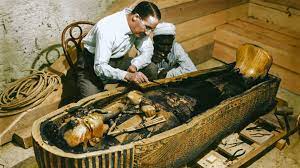
Egypt’s Valley of the Kings in the 19th century was a favorite place of world archaeologists, because many valuable gold objects could be discovered in this area. Unfortunately, due to the high value of the items found, it was also a favorite of numerous robbers who emptied, stole and sold everything could be sold. The saddest thing of all is that most of the found and stolen things are never written down.
When Howard Carter arrived in Egypt in 1891, he was convinced that an undiscovered and unrobbed tomb was hidden there, but no one agreed with him. Thanks to his persistence and dedication, but also to the financial resources of Lord Carnarvorn, who supported his work, in November 1922, the English archaeologist finally found what he was looking for.
In the ruins of the Valley of the Kings, he discovered hidden steps that led to a 3,300-year-old tomb above which was written the name Tutankhamun. The sealed area consisted of four rooms, which the archaeological team began to explore.
On February 16, 1923, he finally stepped into the last room – the tomb of Pharaoh Tutankhamun, and what he found there changed the face of archeology forever. Since the Egyptians considered the pharaohs gods, after death they mummified their bodies and filled the tomb with gold, clothes, weapons, jewelry and other valuable items.
Carter and his colleagues found untold wealth in the tomb. He had a gold death mask on his face, which today is considered the most famous object found in Tutankhamun’s tomb.

Although there was an inscription above the sarcophagus: Death will overtake those who disturb the pharaoh’s sleep, at first no one paid attention to it. But considering that 12 people from this expedition died suddenly within six weeks of the opening of the tomb, stories about Tutankhamun’s curse began to spread.
Two months after the opening of Tutankhamun’s tomb, Lord Carnarvorne also died. The day after Lord’s death, his close friend George Gold came to investigate the matter. He entered the pharaoh’s tomb, a few hours later he developed a high fever and died.
By 1930, 22 people had died who participated in the opening of the tomb, which further spread the story of Tutankhamun’s curse.
So is there any truth behind this curse? Can a person really get sick from an ancient grave?
The European and American public, already affected by Egyptomania, was also gripped by the idea of the curse of the mummy. Newspapers sensationally published news about the death of members of the expedition and their relatives. Richard Bethell – Howard Carter’s assistant, Bethell’s father – Lord Westbury, A.C. Mace – Carter’s partner and Elizabeth Carnarvon are victims of Pharaoh’s revenge against journalists. Judging by the list of victims, native Egyptians were not affected by the curse. Carter, who was as popular for surviving the curse (at least until 1939, when he died) as for finding the mummy, hated the sensationalism created around the excavation. He was deeply disturbed by the public’s desire to hear so much about superstition. He even tried to convince people that pharaonic curses did not exist at all in Egyptian rites for the dead. Inscriptions on graves often contained protective formulas, messages to frighten enemies from this or that world, but usually contained good wishes for the buried.
But like all curses, the one about Tutankhamun’s tomb stuck in the public imagination. Eighty years after the opening of the tomb, the British Medical Journal published a scientific study on the curse of the mummy. Mark R. Nelson of Monash University in Australia, examined the survival rate of 44 Westerners who according to Carter’s records were in Egypt during the excavation and inspection of the tomb. It’s Nelson
assumed that the curse as a physical entity had the power to harm only those who were physically present at the opening of the chamber or casket (thus excluding Lord Carnarvon’s dog). Nelson defined several specific dates for the exhibition: February 17, 1922 – the opening of the third door, February 3, 1926 – the opening of the sarcophagus, October 10, 1926 – the opening of the coffin and November 11, 1926 – the examination of the mummy.
Of the 44 Westerners identified, 25 were present during the opening or examination. These 25 lived an average of 20.8 years after exposure, and those who were not exposed lived an average of 28.9 years after 1926. The average age at death for those who were exposed was 70, and for those who were not exposed for 75 years. Nelson determined through this research that there is no such thing as a curse.
Could exposure to poisonous pathogens in the tomb
lead to the death of an already sick man?
Carter claimed that the grave was free of bacterial matter, but modern research shows that bacteria that attack the respiratory organs may be present in ancient tombs. Sarcophagi contain formaldehyde, hydrogen sulphide and ammonia gas – all substances that damage the lungs. Ancient meat, fruit and vegetables found in burial offerings, not to mention mummified human bodies, can attract dangerous molds such as Aspergillus niger and Aspergillus flavus, while bat droppings can grow fungi.
But regardless of the potential for unpleasant micro-organisms, experts believe that Lord Carnarvon’s death is not linked to the tomb. He died outside the research season, at a time of year when it is too hot to dig in Egypt. He could have been exposed to bacteria, fungus and mold for months before his death.

Leave a comment